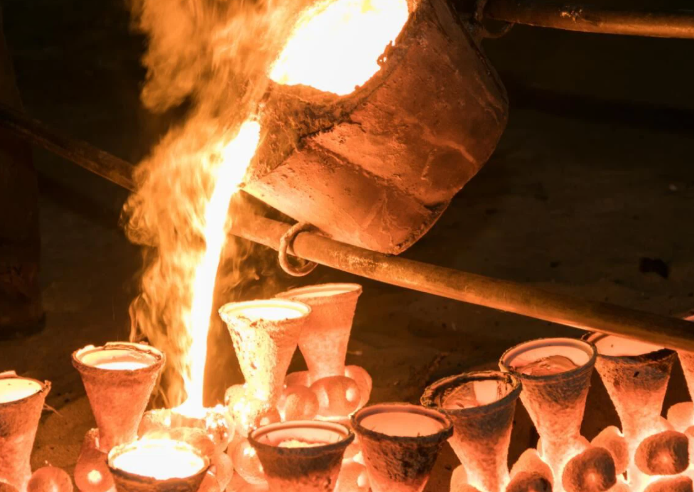Castings defects and improvement measures
1. Porosity
1.1. Entrained pores: generally spherical, spherical or oblate, with a size of several millimeters, smooth pore walls, oxidized inner walls, diffusely distributed in the casting cross section in the inner gate action area
1.2. Precipitation pores: generally spherical or spherical, with a pore size of less than 1 mm, smooth and shiny pore walls, metallic color, covered with a layer of carbon film or graphite film on the pore walls, generally diffusely distributed
1.3. Invasive pores: pores are generally larger in size, spherical, spherical or pear-shaped; the small head of the pear-shaped pore points to the direction of the external gas source; the pore wall is smooth, blue when the invading gas component is mainly CO, metallic and shiny when the invading gas component is mainly hydrogen, and oxidized and dark when the invading gas component is mainly water vapor. Generally appear in the upper part of the casting, single distribution or local aggregation
Causes of formation:
A. The bubbles carried by the metal liquid flow or the impact of the liquid flow will draw the gas into the metal liquid, and when the gas cannot be discharged, pores will be formed
B. There are three gas elements, O, H, and N, in the molten iron. The solubility of the three gas elements suddenly decreases during the solidification process. After precipitation, they exist in the form of gas to form pores. C. Rusting of the furnace charge, high AL content of the inoculant is easy to generate pores. D. The sand core has a large amount of gas, and it is easy to form pores when it is damp or the coating is not dry. E. The permeability of the molding sand is poor or the water content is high. F. System exhaust Unsmooth
G. The design of the scheme is unreasonable, and the molten iron forms vortex air during the pouring process
Castings defects improvement measures:
A. Quickly fill the mold and punch the mold at the same time to avoid the formation of pores due to excessive water content in the sand mold caused by “water migration”
B. Set up exhaust channels or overflow risers to allow the gas to be discharged smoothly
C. Correctly select the flow area to avoid the formation of vortex air during the pouring of molten iron. After the scheme is completed, use the Reynolds formula to check whether the metal in the pouring channel is laminar or turbulent
In casting production, it is obviously impossible to make the metal flow in the pouring system laminar, but it can be made non-turbulent. Increase the temperature at the pore position (increase water inlet, increase pouring temperature, etc.). Create conditions for gas to float
2. White cast iron
Castings defects characteristics:
White cast iron castings are hard and brittle, and are white when broken and difficult to process
Causes:
A. Low CE value
B. Casting cooling speed is too fast
C. Casting pouring speed is slow, temperature is low, and white cast iron is easy to form in thin walls or thin beams
D. The content of white cast iron elements such as hydrogen, rare earth, and magnesium in molten iron is high
Improvement measures:
A. It is recommended to increase the CE value and increase the inoculant dosage B. Increase the temperature of the white cast iron position. (Speed up the pouring speed or increase the gate temperature) C. Increase water inlet at the white cast iron position D. Add overflow risers at the white cast iron position E. Improve the heat distribution around the white cast iron position. Reduce cooling rate and improve white mouth
3. Loss of meat
Defect characteristics:
After removing the riser, there is less meat at the riser neck
Cause of formation:
The shape and size of the riser neck are unreasonable or the slot position is wrong
Castings defects Improvement measures:
A. Reduce the cross-sectional area of the riser neck
B. Improve the shape of the riser neck
C. It is recommended to improve the method of removing the riser, such as using a saw riser, etc.
D. Add a slot on the riser neck. (Generally a 90-degree slot) to disconnect the casting and the riser from the slotted part
4. Poor core setting
Causes:
A. Poor fit between sand core and outer mold
B. Too small positioning surface of sand core
Improvement measures:
A. Paste copper sheet on the sand extrusion part or enlarge the model there, increase the seam, so that the sand core can be smoothly put in place
B. When designing and making the plan, try not to set the riser and flow path on the positioning surface of the sand core to avoid core deviation or sand extrusion
5. Insufficient elongation
Causes:
A. Insufficient smoothness of the test rod
B. Unreasonable composition of molten iron
C. Too fast cooling speed of casting
D. Shrinkage and shrinkage at the rod stretching position
Improvement measures: A. It is recommended to improve the composition of molten iron
B. Increase the riser at the shrinkage position to improve shrinkage
C. Improve heat distribution, obtain ideal temperature gradient and solidification sequence, and thus obtain densely organized castings
6. Uneven hardness and coarse graphite
Uneven hardness: The hardness deviation at different positions of the same casting is too large, exceeding the hardness range required by the customer
Coarse graphite: The graphite size in the metallographic structure is too large, or there is blocky graphite, and there are many small pits distributed on the machining surface of the casting. Affects the finish and other properties of the casting
Cause of formation: Uneven hardness is the result of different wall thickness, different structure, different solidification temperature and speed of the casting. Coarse graphite is the result of excessive growth of graphite, which is related to high CE value or slow cooling speed.
Castings defects Improvement measures:
A. If the graphite at the water entry position is coarse. Change the water entry position. Keep the water entry position away from the coarse graphite position
B. Generally speaking, the water entry position of castings with the same wall thickness has lower hardness than other positions. Therefore, changing the water entry position or increasing the riser at the high hardness position will balance the hardness
C. Reconsider improving the heat distribution of the entire panel, strive for reasonable heat distribution, moderate solidification speed, and correct sequence, so as to obtain a casting with dense and uniform structure and performance that meets the requirements
D. It is recommended to reduce the CE value to enhance the inoculation effect and improve the graphite size





